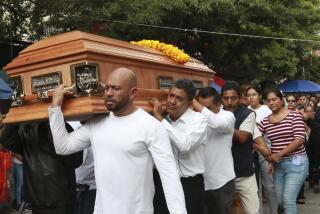‘Coca Power’ Winning Bolivian Drug War : Latin America: Growers of cocaine plant vow to resist U.S. pressure to stop.
- Share via
COCHABAMBA, Bolivia — Peasants who grow coca in the hot and humid lowlands here are engaged in a high-stakes battle of wills with the mighty United States.
Guess who’s winning.
Washington has spent a fortune in Bolivia’s tropical Chapare region to slash production of coca leaves, the raw material of cocaine. And coca growers, called cocaleros , have gladly accepted millions of dollars in Yankee aid. But by official U.S. calculations, Chapare coca fields increased from 83,000 acres in 1991 to 83,700 acres in 1994.
It seems the cocaleros have snookered Uncle Sam. Pressed by Washington, successive Bolivian administrations have promised to eradicate coca from the Chapare, but the cocaleros have prevailed, relying on a powerful combination of public sympathy, political poker--and the threat of violence.
Now the Chapare’s formidable farmers face what could be their stiffest challenge yet. The government, under increased U.S. pressure, is moving ahead with an anti-coca crackdown that American officials are applauding enthusiastically.
“The initiative is with the government, not the cocaleros , and that’s a complete turnaround,” said one U.S. official.
But cocalero leaders say their organizations will resist with all their power, and they warn that police action could trigger escalating violence. Three Chapare farmers already have been killed in coca disputes this year.
Coca growers in Bolivia, Peru and Colombia are the first link in a multibillion-dollar cocaine chain. They are not rich, ruthless drug lords; their bushes with thumb-size leaves often are not hard to find. But in different ways, the cocaleros have proven as hard to handle as international networks of big-time drug traffickers or inner-city armies of small-time crack peddlers.
In Bolivia, the personification of Coca Power is Evo Morales, tireless cocalero organizer and propagandist, fiery defender of a cash crop that turns into a dangerous drug. Morales, 37, has done more than anyone to keep coca in the Chapare.
Call him Senor Coca. He insists that farmers all over the mountains north of Cochabamba have the right and the need to grow their controversial crop. “As long as there are no alternatives they can make a living from, they will continue producing coca,” he vowed this month, sitting in front of a coca-leaf display on the wall of his Cochabamba office.
Cocaine trafficking gave a $356-million boost to the Bolivian economy last year, according to estimates by drug policy experts. About 10% of Bolivia’s work force receives its income from drug-related activities.
Growing coca has always been legal in Bolivia. Native people chew the leaf as a mild stimulant and use it in religious and social ceremonies. But since the 1970s, Bolivia has produced many thousands of tons more than the country uses for traditional consumption. Almost all Chapare coca is refined into cocaine and sent illegally to the United States and Europe.
Still, Morales adamantly argues that coca is not cocaine, that Chapare cocaleros are part of a proud cultural tradition.
Many Bolivians agree.
On a recent Friday evening, the San Simon University in Cochabamba sponsored an open-air concert by Arawi, a popular native musical group wearing brightly colored ponchos and porkpie hats, to honor the “sacred leaf.” During intermission, Morales gave a short speech while others passed out coca for the overflow crowd to chew “in homage to the defense of coca.”
A message from Morales on the concert program appealed for “struggles of resistance for our sovereignty in the face of constant provocations by the capitalist system.”
Morales’ rhetoric rings with words such as class struggle and revolution . He portrays the cocalero cause as a fight for Bolivian rights, culture and independence against capitalist exploitation and U.S. imperialism.
The United States helps train and finance an anti-drug police force, “the Leopards,” that is widely scorned. The force has been accused of human rights violations, corruption and other abuses in the Chapare. Its mission is to hunt down cocaine traffickers, not coca farmers. But the difference is not always clear. Authorities say many farmers process leaves into cocaine paste by mashing them with kerosene in plastic-lined pits. “These aren’t just poor innocent farmers,” President Gonzalo Sanchez de Lozada said.
Five well-organized federations of farmers, coordinated by Morales, have been wily and agile in adapting their strategies against official anti-coca efforts. The federations represent the Chapare’s 25,000 peasant families, or between 100,000 and 125,000 people.
Chapare farmers are a fraction of Bolivia’s 3 million peasants; they are better off than most. Aid programs for “alternative development” for the region, costing hundreds of millions of dollars, have introduced substitute crops, built roads and installed processing plants for farm products. U.N. projects have put piped water and 24-hour electricity in every home.
Although few other rural areas in the country are so prosperous, Sanchez de Lozada noted, polls still show that most Bolivians feel sorry for the cocaleros . “So when we bear down on these people,” he said, “we are perceived as giving some very poor people a very hard time on behalf and for the benefit of a very wealthy country”--the United States.
Tension in the Chapare has been high since early this year, when the United States told Bolivia that it had to eradicate 4,320 acres of coca by July to avoid losing “certification” of its progress in combatting drug traffic.
Under U.S. law, annual certification is required not only for American aid--worth $87 million this year--but for U.S. approval of funds from international agencies such as the World Bank. Bolivia, the poorest country in South America, depends heavily on such financing.
The crackdown began; the cocaleros resisted, and three were killed in separate incidents. In July, the government arrested more than 50 cocalero leaders, including Morales, under a state of siege imposed mainly to control teachers unions. Morales was held for 21 days.
The government more than met the midyear target for coca eradication, but the war is hardly won. If a 12-month goal of 13,300 acres is not met by year’s end, Bolivia will again have problems with U.S. certification.
Coca eradication in the Chapare is not new. A 1988 Bolivian law commits the government to eradicating 12,355 to 19,768 acres a year. Farmers have pulled up a grand total of 66,700 acres of coca in exchange for payments of $2,000 in cash for every 2 1/2 acres and $500 more in aid for planting substitute crops.
More than $60 million has been handed out, mostly by the United States. Theoretically, there should be little coca left in the Chapare. The problem is that, while eradicating old crops, farmers have secretly planted new coca elsewhere.
The 1988 law outlaws new coca plants. There has been little enforcement of the provision, but that is changing with Sanchez de Lozada’s new policy, the president said in an interview.
“The policy should work now that we’re very energetically applying the one missing link, which is control of new plantations and nurseries,” he said.
U.S. spy satellites try to spot coca fields in the Chapare. But farmers have discovered that the images are not detailed enough to show small patches of crops. So in recent years, they have planted mostly in plots no larger than one-fourth of an acre, said Sandro Calvani, an Italian who directs the U.N. Drug Control Program in Bolivia. He said farmers also have outsmarted the Americans by cultivating young coca under broad-leaved manioc plants.
As for Morales, he and his federations have many populist and leftist allies in Bolivia’s Congress and labor movement but, individually, few can match his power. “Evo Morales counts for at least 20 parliamentarians,” Calvani said. “He’s a much more powerful man.”
But Sanchez de Lozada insisted that the government will enforce the 1988 law, despite that strength. “We’re obliged to eradicate, in a forcible manner if they don’t go along voluntarily,” he said. But he added that the policy applies only to coca planted after the end of March.
Pulling out all coca by force would risk a cocalero insurgency, the president said.
“I think these people, when they see that their livelihood and their families’ livelihood are endangered, will quickly accept being armed by the narcos , and we’ll end up with a very serious situation,” he said. “We don’t know if our economy, our society, could support the social and the human and the economic cost of an insurgency.”
Last month, after his release, Morales agreed to negotiate with the government. At one point, he accepted voluntary eradication of all new coca and coca seedbeds. But later he asked for two weeks to consult with federation members about the agreement. The government refused to accept the delay.
The talks broke down earlier this month, and the government said it will go ahead with eradication of seedbeds and new plants, with or without the cooperation of the cocaleros.
Meanwhile, it was business as usual in the Chapare. The other day, farmers could be seen drying coca leaves on the ground in front of their homes alongside rough rural roads. Sacks of leaves were stacked against walls of a large, open shed that serves as a coca market in a town called Villa 14.
German Felipez, secretary general of the farmers union there, criticized the 1988 anti-coca law, saying: “The law was not written in Bolivia. It was brought from the United States and translated here.”
Without agro-industry that can compete with coca for profits, cocaleros are determined to resist the measure’s enforcement, he said, adding, “The only way is to kill them.”
Colombia’s coca industry presents similar challenges. Story, Los Angeles Times Magazine.
More to Read
Sign up for Essential California
The most important California stories and recommendations in your inbox every morning.
You may occasionally receive promotional content from the Los Angeles Times.










